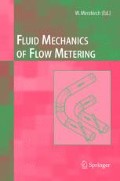Access this chapter
Tax calculation will be finalised at checkout
Purchases are for personal use only
Preview
Unable to display preview. Download preview PDF.
References
Acharya M, Bornstein J, Escudier MP (1986) Turbulent boundary layers on rough surfaces. Experiments in Fluids 4:33–47
Afzal N (1976) Millikan's argument at moderately large Reynolds number. Phys. Fluids 19:600–602
Afzal N (2001): Power law and log law velocity profiles in fully developed turbulent pipe flow: equivalent relations at large Reynolds numbers. Acta Mechanica, Vol. 151:171–183
Afzal N, Yajnik K (1973) Analysis of turbulent pipe and channel flows at moderately large Reynolds number. J. Fluid Mech. 61:23–31
AGARD (1998) A selection of test cases for the validation of large-eddy simulations of turbulent flows. AGARD Advisory Report 345
Barenblatt GI (1993) Scaling laws for fully developed turbulent shear flows. Part I: Basic hypothesis and analysis. J. Fluid Mech. 248:513–520
Barenblatt GI, Chorin AJ (1998) Scaling of the intermediate region in wall-bounded turbulence: The power law. Phys. Fluids, Vol. 10:1043–1044
Barenblatt GI, Chorin AJ, Prostokishin VM (1997a) Scaling laws for fully developed turbulent flow in pipes. Appl. Mech. Rev., Vol. 50:413–429
Barenblatt GI, Chorin AJ, Prostokishin VM (1997b): Scaling laws for fully developed turbulent flow in pipes: Discussion of experimental data. Proc. Natl. Acad. Sci. USA, Vol. 94, 773
Benedict RP (1980) Fundamentals of Pipe Flow. John Wiley Sons, New York
Blasius H (1913) Das Ähnlichkeitsgesetz bei Reibungsvorgängen in Flüssigkeiten. Forschg. Arb. Ing.-Wesen, Heft 131, Berlin
Boussinesq J (1872) Essai sur la theorie des eaux courantes. Memoires Acad. des Sciences, Vol. 13, No. 1, Paris
Bradshaw P (2000) A note on “critical roughness height” and “transitional roughness”. Phys. Fluids 12:1611–1614
Churchill SW (2001) Turbulent flow and convection: the prediction of turbulent flow and convection in a round tube. In: Advances in Heat Transfer, Academic Press, San Diego, Vol. 34:255–361
Colebrook CF (1938/1939) Turbulent flow in pipes with particular references to the transition region between the smooth and the rough pipe laws. J. Inst. Civil Eng., London, 11:133–156 and 12:393–422
Colebrook CF, White CM (1937) Experiments with fluid friction in roughened pipes. Proc. Royal Soc., London, Series A 161:367–381
den Toonder JMJ (1995) Drag reduction by polymer additives in a turbulent pipe flow: Laboratory and numerical results. Ph. D. thesis, Delft University of Technology
Durst F, Jovanovic J, Sender J (1995) LDA measurements in the near-wall region of a turbulent pipe flow. J. Fluid Mech. 295:305–335
Gersten K, Herwig H (1992) Strömungsmechanik-Grundlagen der Impuls-, Wärme-und Stoffübertragung aus asymptotischer Sicht. Vieweg-Verlag, Braunschweig, Wiesbaden
Gersten K, Papenfuss HD, Kurschat T, Genillon P, Fernández Pérez F, Revell N (2000) New transmission-factor formula proposed for gas pipelines. Oil & Gas Journal, February 14
Grigson CWB (1984) Nikuradse's experiment. AIAA Journal 22:999–1001
Kestin J, Richardson PD (1963) Heat transfer across turbulent incompressible boundary layers. Int. J. Heat Mass Transfer 6:147–189. Also: Forsch. Ing.-Wesen 29:93–104
McKeon BJ, Li J, Jiang W, Morrison JF, Smits A (2003a) Pitot probe corrections in fully-developed turbulent pipe flow. Meas. Sci. Technol. 14:1449–1458
McKeon BJ, Morrison JF, Jiang W, Li J, Smits AJ (2003b) Revised log-law constants for fully-developed turbulent pipe flow. In: AJ Smits (Ed.): IUTAM Symposium on Reynolds Number Scaling in Turbulent Flow. Kluwer Academic Publishers, Dordrecht
McKeon BJ, Li J, Jiang W, Morrison JF, Smits AJ (2004): Further observations on the mean velocity in fully-developed pipe flow. J. Fluid Mech. 501:135–147
Nikuradse J (1932) Gesetzmäßigkeiten der turbulenten Strömung in glatten Rohren. VDI-Forsch. Arb. Ing.-Wesen
Nikuradse J (1933) Strömungsgesetze in rauhen Rohren. VDI-Forsch.-Heft 361; VDI-Verlag, Berlin
Revell N (1998) Internal Report of BG Technology, PR 091
Reichardt H (1951) Vollständige Darstellung der turbulenten Geschwindigkeitsverteilung in glatten Leitungen. Z. angew. Math. Mech. 31:203–219
Rotta JC (1956) Experimenteller Beitrag zur Entstehung turbulenter Strömung im Rohr. Ing. Arch. 24:258–281
Schlichting H, Gersten K (2000) Boundary-Layer Theory. Springer-Verlag, Berlin, Heidelberg; 8th Edition, Corrected Printing 2003
Schultz MP (2002) The relationship between frictional resistance and roughness for surfaces smoothed by sanding. J. Fluids Eng. 124:492–499
Speidel L (1962) Determination of the necessary surface quality and possible losses due to roughness in steam turbines. Elektrizitätswirtschaft 61:799–804
Uhl AE (1965) Steady flow in gas pipelines. American Gas Association. Technical Report No. 10
Van Dyke M (1975) Perturbation Methods in Fluid Mechanics. The Parabolic Press, Stanford, California
von Kármán Th (1930) Mechanische Ähnlichkeit und Turbulenz. Nachr. Ges. Wiss. Göttingen. Math. Phys. Klasse: 58–76 und Verhandlg. des III. Intern. Kongresses für Techn. Mechanik, Stockholm, Teil I:85–93
Waigh DR, Kind RJ (1998) Improved aerodynamic characterization of regular three-dimensional roughness. AIAA J. 36: 1117–1119
Wosnik M, Castillo L, George WK (2000) A theory for turbulent pipe and channel flows. J. Fluid Mech. 421:115–145
Zagarola MW, Smits AJ (1998) Mean-flow scaling of turbulent pipe flow. J. Fluid Mech. 373:33–79
Author information
Authors and Affiliations
Editor information
Rights and permissions
Copyright information
© 2005 Springer-Verlag Berlin Heidelberg
About this chapter
Cite this chapter
Gersten, K. (2005). Fully Developed Turbulent Pipe Flow. In: Merzkirch, W. (eds) Fluid Mechanics of Flow Metering. Springer, Berlin, Heidelberg. https://doi.org/10.1007/3-540-26725-5_1
Download citation
DOI: https://doi.org/10.1007/3-540-26725-5_1
Publisher Name: Springer, Berlin, Heidelberg
Print ISBN: 978-3-540-22242-2
Online ISBN: 978-3-540-26725-6
eBook Packages: EngineeringEngineering (R0)

